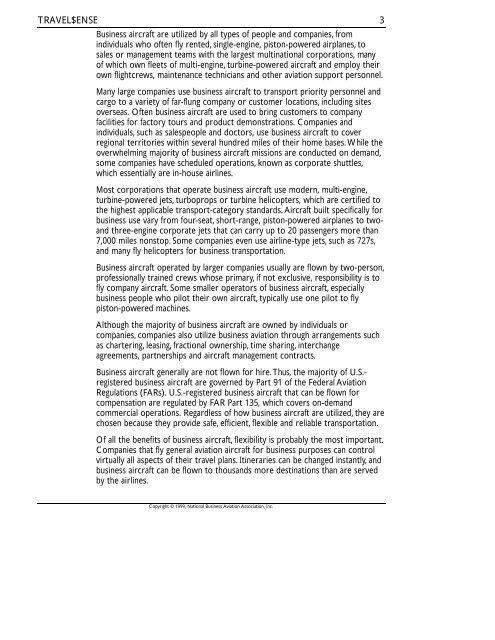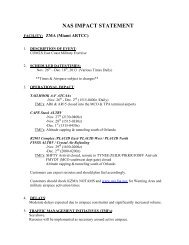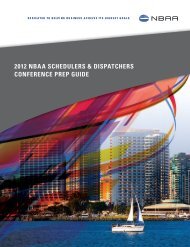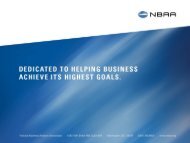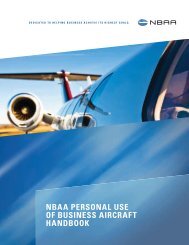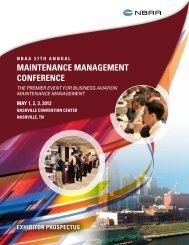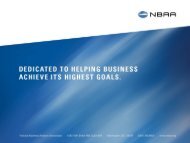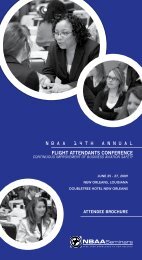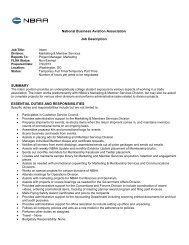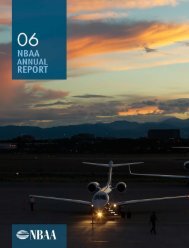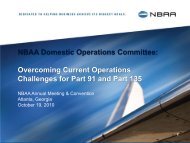Travel$ense User's Guide (PDF, 139 MB) - NBAA
Travel$ense User's Guide (PDF, 139 MB) - NBAA
Travel$ense User's Guide (PDF, 139 MB) - NBAA
- No tags were found...
Create successful ePaper yourself
Turn your PDF publications into a flip-book with our unique Google optimized e-Paper software.
TRAVEL$ENSEBusiness aircraft are utilized by all types of people and companies, fromindividuals who often fly rented, single-engine, piston-powered airplanes, tosales or management teams with the largest multinational corporations, manyof which own fleets of multi-engine, turbine-powered aircraft and employ theirown flightcrews, maintenance technicians and other aviation support personnel.Many large companies use business aircraft to transport priority personnel andcargo to a variety of far-flung company or customer locations, including sitesoverseas. Often business aircraft are used to bring customers to companyfacilities for factory tours and product demonstrations. Companies andindividuals, such as salespeople and doctors, use business aircraft to coverregional territories within several hundred miles of their home bases. While theoverwhelming majority of business aircraft missions are conducted on demand,some companies have scheduled operations, known as corporate shuttles,which essentially are in-house airlines.Most corporations that operate business aircraft use modern, multi-engine,turbine-powered jets, turboprops or turbine helicopters, which are certified tothe highest applicable transport-category standards. Aircraft built specifically forbusiness use vary from four-seat, short-range, piston-powered airplanes to twoandthree-engine corporate jets that can carry up to 20 passengers more than7,000 miles nonstop. Some companies even use airline-type jets, such as 727s,and many fly helicopters for business transportation.Business aircraft operated by larger companies usually are flown by two-person,professionally trained crews whose primary, if not exclusive, responsibility is tofly company aircraft. Some smaller operators of business aircraft, especiallybusiness people who pilot their own aircraft, typically use one pilot to flypiston-powered machines.Although the majority of business aircraft are owned by individuals orcompanies, companies also utilize business aviation through arrangements suchas chartering, leasing, fractional ownership, time sharing, interchangeagreements, partnerships and aircraft management contracts.Business aircraft generally are not flown for hire. Thus, the majority of U.S.-registered business aircraft are governed by Part 91 of the Federal AviationRegulations (FARs). U.S.-registered business aircraft that can be flown forcompensation are regulated by FAR Part 135, which covers on-demandcommercial operations. Regardless of how business aircraft are utilized, they arechosen because they provide safe, efficient, flexible and reliable transportation.Of all the benefits of business aircraft, flexibility is probably the most important.Companies that fly general aviation aircraft for business purposes can controlvirtually all aspects of their travel plans. Itineraries can be changed instantly, andbusiness aircraft can be flown to thousands more destinations than are servedby the airlines.3Copyright © 1999, National Business Aviation Association, Inc.


